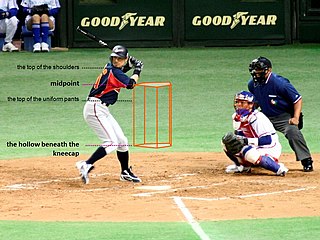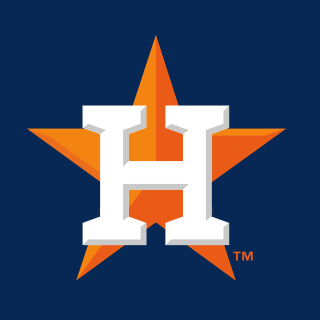Baseball statistics refers to a variety of metrics used to evaluate player and team performance in the game of baseball.
In baseball, an earned run is any run that was fully enabled by the offensive team's production in the face of competent play from the defensive team. Conversely, an unearned run is a run that would not have been scored without the aid of an error or a passed ball committed by the defense.

In baseball, a home run is scored when the ball is hit in such a way that the batter is able to circle the bases and reach home plate safely in one play without any errors being committed by the defensive team. A home run is usually achieved by hitting the ball over the outfield fence between the foul poles without the ball touching the field.

In baseball, the strike zone is the volume of space through which a pitch must pass in order to be called a strike even if the batter does not swing. The strike zone is defined as the volume of space above home plate and between the batter's knees and the midpoint of their torso. Whether a pitch passes through the zone is decided by an umpire, who is generally positioned behind the catcher.

A baseball is the ball used in the sport of baseball. It consists of a rubber or cork center wrapped in yarn and covered with white natural horsehide or cowhide, or a synthetic composite leather. A regulation baseball is 9 to 9.25 inches in circumference i.e. 2.86 to 2.94 inches in diameter, with a weight of 5 to 5.25 ounces.

In baseball, the dead-ball era lasted from about 1900 to 1920. This era was characterized by low-scoring games and a lack of home runs; in 1908, the major league batting average dropped to .239, and teams averaged just 3.4 runs per game, the lowest ever. Spacious ballparks limited hitting for power, and the ball itself was "dead" both by design and from overuse. Ball scuffing and adulteration by pitchers, particularly the spitball, were allowed, putting hitters at a disadvantage.

Justin Brooks Verlander is an American professional baseball pitcher for the Houston Astros of Major League Baseball (MLB). He has previously played in MLB for the Detroit Tigers and New York Mets. From Manakin-Sabot, Virginia, Verlander attended Old Dominion University (ODU) and played college baseball for the Monarchs. He broke the Monarchs' and Colonial Athletic Association's career records for strikeouts. At the 2003 Pan American Games, Verlander helped lead the United States national team to a silver medal.
This is an alphabetical list of selected unofficial and specialized terms, phrases, and other jargon used in baseball, along with their definitions, including illustrative examples for many entries.

Johnny Cueto Ortiz is a Dominican professional baseball pitcher in the Texas Rangers organization. He has previously played in Major League Baseball (MLB) for the Cincinnati Reds, Kansas City Royals, San Francisco Giants, Chicago White Sox and Miami Marlins.
The 2011 Detroit Tigers season was the team's 111th season. The season began on March 31 at New York against the Yankees, and the home opener was on April 8 against the Kansas City Royals. The Tigers honored the late Sparky Anderson during the season. The Tigers sent five players to the 2011 Major League Baseball All-Star Game: starting pitcher Justin Verlander, first baseman Miguel Cabrera, catcher Alex Avila, shortstop Jhonny Peralta, and closer José Valverde. The regular season concluded September 28 at home against the Cleveland Indians, with the Tigers holding a 95–67 record.

The 2012 World Series was the championship series of Major League Baseball's (MLB) 2012 season. The 108th edition of the World Series, the series was a best-of-seven playoff between the National League (NL) champion San Francisco Giants and the American League (AL) champion Detroit Tigers; the Giants won in a four-game sweep. This marked the Giants' seventh World Series title in franchise history, their second in San Francisco, and their second in a three-year period (2010–2012). Their World Series sweep was the first by an NL team since the Cincinnati Reds swept the Oakland Athletics in the 1990 series and the first NL sweep not by the Reds since 1963, when the Los Angeles Dodgers swept the New York Yankees. This was also the first World Series since 1988 to feature both of that year's League MVPs. The Giants' Pablo Sandoval, who in Game 1 tied a record by hitting three home runs in one World Series game — two off Tigers' ace pitcher Justin Verlander — was named the World Series Most Valuable Player (MVP).
The 2015 Cincinnati Reds season was the 126th season for the franchise in Major League Baseball, and their 13th at Great American Ball Park, which hosted the 2015 Major League Baseball All-Star Game on Tuesday, July 14. The Reds finished the season with a record of 64–98, 36 games behind the St. Louis Cardinals, second-worst in the National League, and their worst finish since 1982.

In baseball, pace of play refers to the length of time between in-game action, specifically the length of time a pitcher takes between their pitches. A slow pace of play can extend the length of games, which is regarded as an issue in college baseball and professional baseball. To accelerate the pace of play, leagues have instituted rule changes, such as the implementation of a pitch clock in Major League Baseball.

The 2017 Detroit Tigers season was the team's 117th season. This was the team's fourth and final year under manager Brad Ausmus. This was the first season without owner Mike Ilitch, who bought the team in 1992 and died on February 10, 2017. The Tigers 2017 uniform features a "Mr. I" patch to honor him, the grounds crew wrote "Mr. I" in the outfield of Comerica Park, and he was also honored during a ceremony at the Tigers home opener on April 7.
The 2019 Major League Baseball season began on March 20, while the regular season ended on September 29. It was the 150th anniversary of professional baseball, dating back to the 1869 foundation of the Cincinnati Red Stockings. The postseason began on October 1. The World Series began October 22 and ended October 30 with the Washington Nationals defeating the Houston Astros in seven games to win their first World Series championship. The entire schedule was released on August 22, 2018.

The 2019 Houston Astros season was the 58th season for the Major League Baseball (MLB) franchise in Houston, Texas, their 55th as the Astros, seventh in both the American League and American League West, and 20th at Minute Maid Park.

The 2019 American League Championship Series was a best-of-seven series between the two winners of the 2019 American League Division Series, the Houston Astros and New York Yankees, for the American League (AL) pennant and the right to play in the 2019 World Series. The Astros defeated the Yankees in six games, advancing to face the 2019 National League champions, the Washington Nationals, whom they lost to in seven games.

The 2022 Chicago White Sox season was the club's 123rd season in Chicago, their 122nd in the American League and their 32nd at Guaranteed Rate Field.

The 2022 Houston Astros season was the 61st season for the Houston Astros, a Major League Baseball (MLB) franchise located in Houston, Texas, their 58th as the Astros, 10th in both the American League and American League West, and 23rd at Minute Maid Park. The Astros entered the season as both the defending AL and AL West champions, and they looked to avenge their 2021 World Series loss to the Atlanta Braves in six games.











